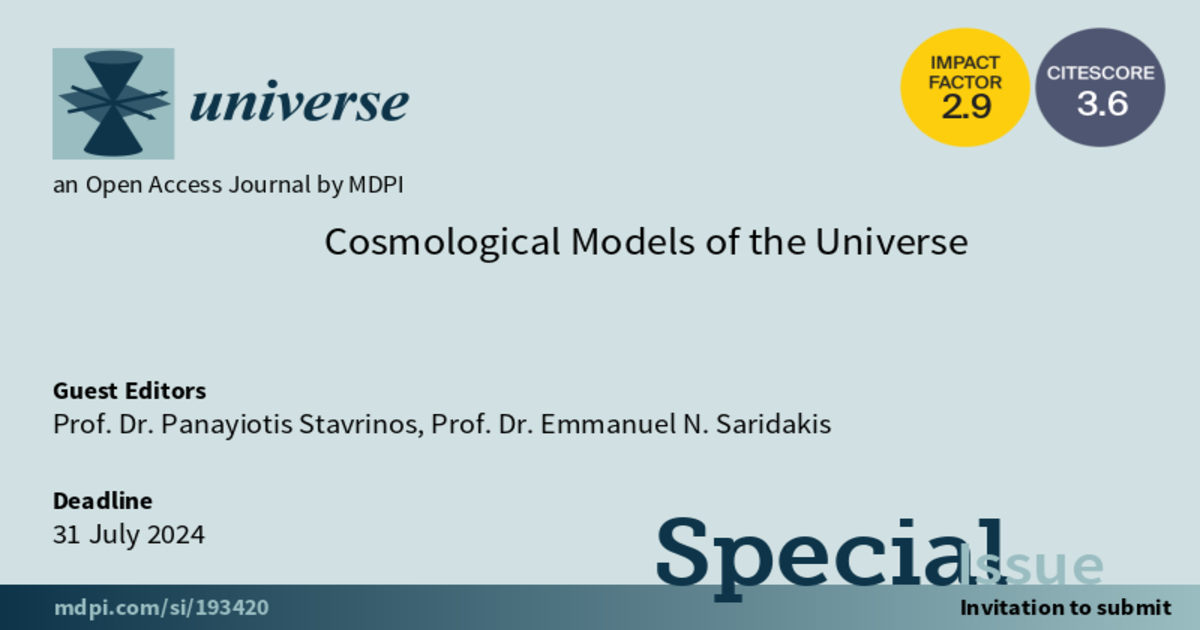Cosmological Models of the Universe
A special issue of Universe (ISSN 2218-1997). This special issue belongs to the section "Cosmology".
Deadline for manuscript submissions: 31 July 2024 | Viewed by 1090

Special Issue Editors
Interests: modified gravity; cosmology; gravitational waves; Finsler cosmology; extended Friedmann equations; dark matter
Special Issues, Collections and Topics in MDPI journals
2. CAS Key Laboratory for Researches in Galaxies and Cosmology, Department of Astronomy, University of Science and Technology of China, Hefei 230026, China
3. Departamento de Matemáticas, Universidad Católica del Norte, Avda. Angamos 0610, Casilla, Antofagasta 1280, Chile
Interests: ark energy formulation; modified theories of gravity; inflationary cosmology; brane cosmology; observational cosmology
Special Issues, Collections and Topics in MDPI journals
Special Issue Information
Dear Colleagues,
Cosmological models are described by mathematical formulas that attempt to explain the current behavior and evolution of the universe over time. They are based on observations making predictions that can be effective by resultant investigations and rely on general relativity because that theory describes the best way that the large-scale behavior of spacetime can be observed. Cosmological models extend the form of general relativity through various methods, leading to different field equations and thus to different cosmological implications. They play an essential role and contribute to modern cosmology, providing a foundation for the current understanding of the physical phenomena of the universe. A fundamental category of cosmological models is inflationary models which provide potential solutions to the fundamental problems of standard cosmological models on Big Bang cosmology, i.e., the Flatness and Horizon problem. Additionally, these models sufficiently describe energy density fluctuation mechanisms that investigate the large-scale structure of the universe. The measurement of CMB polarization and its anisotropies has a great significance to early universe physics, and the mechanisms of matter creation generate primordial metric fluctuations that affect the geometry of the universe (e.g., inflationary models). The abovementioned cosmological model provides observational tests which explain the origin of light and the existence of the cosmic microwave background and establishes the fact that the universe has a thermal history. On the other hand, the study of the large-scale structure of the universe and observational evidence demands the existence of dark matter and a nonzero cosmological constant; investigations in this direction introduce a model known as the ΛCDM model. As well, anisotropic cosmological models have been developed when the underline geometry of spacetime has a more generalized metric structure than the Riemannian one. Topics of interest for this Special Issue include, but are not limited to, the following: Standard cosmological models; Inflationary cosmological models; ΛCDM cosmological model; Anisotropic cosmological models; Finsler cosmology.
Prof. Dr. Panayiotis Stavrinos
Prof. Dr. Emmanuel N. Saridakis
Guest Editors
Manuscript Submission Information
Manuscripts should be submitted online at www.mdpi.com by registering and logging in to this website. Once you are registered, click here to go to the submission form. Manuscripts can be submitted until the deadline. All submissions that pass pre-check are peer-reviewed. Accepted papers will be published continuously in the journal (as soon as accepted) and will be listed together on the special issue website. Research articles, review articles as well as short communications are invited. For planned papers, a title and short abstract (about 100 words) can be sent to the Editorial Office for announcement on this website.
Submitted manuscripts should not have been published previously, nor be under consideration for publication elsewhere (except conference proceedings papers). All manuscripts are thoroughly refereed through a single-blind peer-review process. A guide for authors and other relevant information for submission of manuscripts is available on the Instructions for Authors page. Universe is an international peer-reviewed open access monthly journal published by MDPI.
Please visit the Instructions for Authors page before submitting a manuscript. Submitted papers should be well formatted and use good English. Authors may use MDPI's English editing service prior to publication or during author revisions.
Keywords
- standard cosmological model
- dark matter
- dark energy
- bounce cosmology
- inflation cosmology
- ΛCDM-cosmology
- anisotropic cosmology






